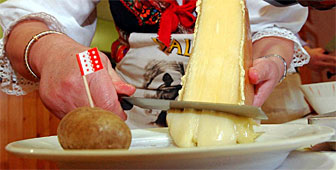Raclette producers face meltdown

The rights to the name of one of Switzerland's most popular cheeses - Raclette - is driving a wedge between purists and its biggest producers.
Raclette is the key ingredient of one of Switzerland’s most popular dishes: the eponymous cheese is melted under a special grill and scraped onto a plate with potatoes and pickles. Like fondue, it is all about conviviality.
But there’s nothing convivial about the increasingly acrimonious tug-of-war that has been going on for the past five years over the rights to the name Raclette, which comes from the French word “racler” – to scrape.
Authenticity
The problems began in 1997 when the Federal Agriculture Office introduced its Protected Denomination of Origin system. Better known by its French acronym, AOC, this classification seeks to guarantee the authenticity of regional specialities.
Producers in the southern canton of Valais, where Raclette has been made and consumed for centuries, immediately applied for AOC status for their cheese.
If Valais producers win AOC approval, no other cheese makers in Switzerland will be able to use the term.
The AOC system is better known as a method of denominating wine. In Switzerland, this is administered by the cantons. But the classification of non-wine products is carried out by the Federal Agriculture Office.
So far seven regional products, including four cheeses – Etivaz, Gruyère, Tête-de-Moine and Sbrinz -have been granted this prized label.
Gruyère’s application led to a bit of a stink – many producers employed the ancestral methods, but were located outside traditional boundaries of Gruyère region – but a compromise was eventually reached. Such an agreement is proving elusive for Raclette.
Fundamentalist
“Raclette is from the Valais and should be reserved only for cheeses from the Valais,” says Alphonse Jacquier, the director of the Valais Dairy Federation. He rejects accusations, though, that his federation has adopted a “fundamentalist” approach.
“We are a group of producers who looking for recognition of a fabulous product,” he told swissinfo. Jacquier argues that most Swiss people associate Raclette with the canton, and to allow others to use the name Raclette is “cheating the consumer”.
Some non-Valais producers even go so far as to use some of the canton’s most famous images – the Matterhorn and fighting cows, for example – on their packaging, something they would not longer be able to do if AOC status is granted.
Well-founded application
The Federal Agriculture Office agrees that Valais’s case for AOC status is well founded, having satisfied a number of criteria regarding originality, geography, history, techniques, ageing periods and so on.
“It is distinctive,” says Frédéric Brand, the Federal official in charge of the AOC system. “The problem is what we are going to call the denomination.”
Around 50 objections to the Valais’s application have been submitted, and it now seems inevitable that the case will eventually end up before the Federal Court.
“It could take years,” Brand told swissinfo. “But for a product that’s 1,000 years old, that’s not so long.”
The main problem is that, despite being its traditional heartland, the Valais produces only around 15 per cent of the Raclette made in Switzerland.
Livelihoods threatened
“Raclette is a very famous cheese and if we were prevented from using the name, we would not sell as much, and the livelihood of producers outside Valais would be threatened,” says Manfred Boebner, president of the Swiss Raclette Association, which groups together producers from outside the Valais.
“It is even written into Swiss law that we can use this name. This brand has a certain value. It’s not possible to change consumers’ minds, to undo decades of marketing,” he told swissinfo.
The Association represents major producers like the dairy companies Emmi and Swiss Dairy Foods, but also hundreds of smaller producers.
“But their product is a completely different cheese. It has nothing to do with Raclette,” says Jacquier.
“Our product is produced as it was 500 years ago,” he says, pointing out that Valais Raclette is made in small mountain dairies, without additives and with unpasteurised milk from cows that eat only grass and hay. “The other raclette is a good product, but it is more homogenised.”
The Swiss Raclette Association has no objection to the Valais producers being given a special regional AOC classification, as long as the name raclette remains free for use as a generic term.
That appears the likeliest outcome. The biggest stumbling block, though, according to Alphonse Jacquier, is the system itself: “The classification is meant to give a certain exclusivity. How can you protect a product and then allow others to use the name?” he asks.
The answer may have a bearing on the classification of other regional products. The Valais itself – which already has an AOC for its local pear-based eau-de-vie – is awaiting a verdict for other specialities such as its apricot brandy and rye bread.
by Roy Probert

In compliance with the JTI standards
More: SWI swissinfo.ch certified by the Journalism Trust Initiative
You can find an overview of ongoing debates with our journalists here. Please join us!
If you want to start a conversation about a topic raised in this article or want to report factual errors, email us at english@swissinfo.ch.